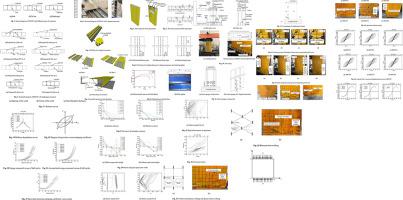当前位置:
X-MOL 学术
›
J. Constr. Steel Res.
›
论文详情
Our official English website, www.x-mol.net, welcomes your
feedback! (Note: you will need to create a separate account there.)
Experimental study on seismic behavior of double-skin composite wall with L-shaped connectors
Journal of Constructional Steel Research ( IF 4.0 ) Pub Date : 2020-11-01 , DOI: 10.1016/j.jcsr.2020.106312 Lihua Chen , Chao Yin , Chenggang Wang , Yuming Liu
Journal of Constructional Steel Research ( IF 4.0 ) Pub Date : 2020-11-01 , DOI: 10.1016/j.jcsr.2020.106312 Lihua Chen , Chao Yin , Chenggang Wang , Yuming Liu

|
Abstract In this paper, the authors' research group propose a novel double-skin composite wall (DSCW), which is composed of boundary columns, steel faceplates, L-shaped connectors and infill concrete. To further study the seismic performance of DSCW specimens, six high shear-span ratio DSCWs were designed and manufactured for a quasi-static test. In the experiment, the welding spacing, welding forms, and the thickness of the steel faceplate are used to set forth parameters; moreover, the failure mode, deformation performance and energy dissipation capacity of the DSCWs are analyzed. Test results show that the failure mode of each specimen was flexural failure, as shown by the fractured steel plate at the bottom of the boundary columns, the crushed infill concrete at the tear, and the specimens' buckled steel faceplates in different degrees. The average value of the yield drift ratio was 1/177; the average value of ultimate drift ratio was 1/39, and the average value of displacement ductility coefficient was 4.46. A good energy dissipation capacity was shown by the specimens as it increased gradually during the testing process. The results show that the local buckling of the steel faceplate can be delayed by reducing the welding spacing and adopting the blossom-form or dense bottom welding arrangement; thus, improve the ductility and energy dissipation capacity of the specimens. When the thickness of the steel faceplate is increased, the local buckling of the steel faceplate is less likely to occur, and the bearing capacity is improved. Based on the theoretical analysis, a buckling stress calculation model is proposed to calculate the buckling stress of the steel faceplate at the bottom of the specimen.
中文翻译:

L型连接件双层复合墙体抗震性能试验研究
摘要 在本文中,作者的研究小组提出了一种由边界柱、钢面板、L 形连接件和填充混凝土组成的新型双层复合墙(DSCW)。为了进一步研究 DSCW 试样的抗震性能,设计和制造了 6 个高剪跨比 DSCW 用于准静态试验。试验中采用焊接间距、焊接形式、钢面板厚度等参数进行设定;此外,分析了DSCWs的失效模式、变形性能和耗能能力。试验结果表明,各试件的破坏模式为弯曲破坏,边界柱底部钢板断裂,撕裂处填充混凝土破碎,试件钢板面板不同程度屈曲。良率漂移比的平均值为1/177;极限漂移比平均值为1/39,位移延性系数平均值为4.46。试件在测试过程中随着能量耗散能力的逐渐增加显示出良好的能量耗散能力。结果表明,减小焊接间距,采用花形或密底焊接布置可以延缓钢面板的局部屈曲;从而提高试件的延展性和耗能能力。当钢面板厚度增加时,钢面板不易发生局部屈曲,承载能力提高。根据理论分析,
更新日期:2020-11-01
中文翻译:

L型连接件双层复合墙体抗震性能试验研究
摘要 在本文中,作者的研究小组提出了一种由边界柱、钢面板、L 形连接件和填充混凝土组成的新型双层复合墙(DSCW)。为了进一步研究 DSCW 试样的抗震性能,设计和制造了 6 个高剪跨比 DSCW 用于准静态试验。试验中采用焊接间距、焊接形式、钢面板厚度等参数进行设定;此外,分析了DSCWs的失效模式、变形性能和耗能能力。试验结果表明,各试件的破坏模式为弯曲破坏,边界柱底部钢板断裂,撕裂处填充混凝土破碎,试件钢板面板不同程度屈曲。良率漂移比的平均值为1/177;极限漂移比平均值为1/39,位移延性系数平均值为4.46。试件在测试过程中随着能量耗散能力的逐渐增加显示出良好的能量耗散能力。结果表明,减小焊接间距,采用花形或密底焊接布置可以延缓钢面板的局部屈曲;从而提高试件的延展性和耗能能力。当钢面板厚度增加时,钢面板不易发生局部屈曲,承载能力提高。根据理论分析,











































 京公网安备 11010802027423号
京公网安备 11010802027423号